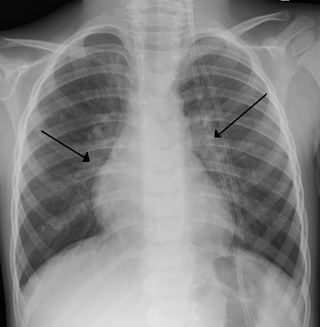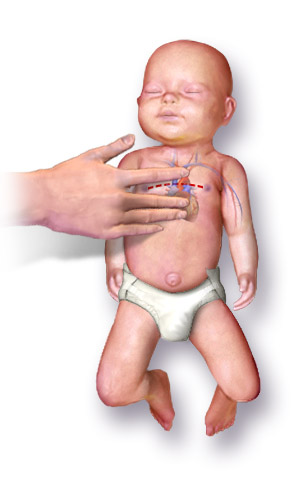Related Research Articles

Pediatrics is the branch of medicine that involves the medical care of infants, children, adolescents, and young adults. In the United Kingdom, paediatrics covers many of their youth until the age of 18. The American Academy of Pediatrics recommends people seek pediatric care through the age of 21, but some pediatric subspecialists continue to care for adults up to 25. Worldwide age limits of pediatrics have been trending upward year after year. A medical doctor who specializes in this area is known as a pediatrician, or paediatrician. The word pediatrics and its cognates mean "healer of children", derived from the two Greek words: παῖς and ἰατρός. Pediatricians work in clinics, research centers, universities, general hospitals and children's hospitals, including those who practice pediatric subspecialties.

Parenteral nutrition (PN) is the feeding of nutritional products to a person intravenously, bypassing the usual process of eating and digestion. The products are made by pharmaceutical compounding companies. The person receives a nutritional mix according to a formula including glucose, salts, amino acids, lipids and vitamins and dietary minerals. It is called total parenteral nutrition (TPN) or total nutrient admixture (TNA) when no significant nutrition is obtained by other routes, and partial parenteral nutrition (PPN) when nutrition is also partially enteric. It is called peripheral parenteral nutrition (PPN) when administered through vein access in a limb rather than through a central vein as central venous nutrition (CVN).

Fluid replacement or fluid resuscitation is the medical practice of replenishing bodily fluid lost through sweating, bleeding, fluid shifts or other pathologic processes. Fluids can be replaced with oral rehydration therapy (drinking), intravenous therapy, rectally such as with a Murphy drip, or by hypodermoclysis, the direct injection of fluid into the subcutaneous tissue. Fluids administered by the oral and hypodermic routes are absorbed more slowly than those given intravenously.

The Apgar score is a quick way for health professionals to evaluate the health of all newborns at 1 and 5 minutes after birth and in response to resuscitation. It was originally developed in 1952 by an anesthesiologist at Columbia University, Virginia Apgar, to address the need for a standardized way to evaluate infants shortly after birth.

Bronchiolitis is inflammation of the small airways in the lungs. Acute bronchiolitis is due to a viral infection usually affecting children younger than two years of age. Symptoms may include fever, cough, runny nose, wheezing, and breathing problems. More severe cases may be associated with nasal flaring, grunting, or the skin between the ribs pulling in with breathing. If the child has not been able to feed properly, signs of dehydration may be present.
The American Academy of Pediatrics (AAP) is the largest professional association of pediatricians in the United States. It is headquartered in Itasca, Illinois, and maintains an office in Washington, D.C. The AAP has published hundreds of policy statements, ranging from advocacy issues to practice recommendations.

Small for gestational age (SGA) newborns are those who are smaller in size than normal for the gestational age. SGA is most commonly defined as a weight below the 10th percentile for the gestational age. SGA predicts susceptibility to hypoglycemia, hypothermia, and polycythemia. By definition, at least 10% of all newborns will be labeled SGA. All SGA babies should be watched for signs of failure to thrive, hypoglycemia and other health conditions.

Short bowel syndrome is a rare malabsorption disorder caused by a lack of functional small intestine. The primary symptom is diarrhea, which can result in dehydration, malnutrition, and weight loss. Other symptoms may include bloating, heartburn, feeling tired, lactose intolerance, and foul-smelling stool. Complications can include anemia and kidney stones.

Failure to thrive (FTT), also known as weight faltering or faltering growth, indicates insufficient weight gain or absence of appropriate physical growth in children. FTT is usually defined in terms of weight, and can be evaluated either by a low weight for the child's age, or by a low rate of increase in the weight.
Necrotizing enterocolitis (NEC) is a devastating intestinal disease that affects premature or very low birth weight infants. Symptoms may include poor feeding, bloating, decreased activity, blood in the stool, vomiting of bile, bowel death, multiorgan failure, and even death.
A volume expander is a type of intravenous therapy that has the function of providing volume for the circulatory system. It may be used for fluid replacement or during surgery to prevent nausea and vomiting after surgery.

A pediatric intensive care unit, usually abbreviated to PICU, is an area within a hospital specializing in the care of critically ill infants, children, teenagers, and young adults aged 0–21. A PICU is typically directed by one or more pediatric intensivists or PICU consultants and staffed by doctors, nurses, and respiratory therapists who are specially trained and experienced in pediatric intensive care. The unit may also have nurse practitioners, physician assistants, physiotherapists, social workers, child life specialists, and clerks on staff, although this varies widely depending on geographic location. The ratio of professionals to patients is generally higher than in other areas of the hospital, reflecting the acuity of PICU patients and the risk of life-threatening complications. Complex technology and equipment is often in use, particularly mechanical ventilators and patient monitoring systems. Consequently, PICUs have a larger operating budget than many other departments within the hospital.

The kidney is injured in approximately 10 percent of all significant blunt abdominal trauma. Of those, 13 percent are sports-related when the kidney, followed by testicle, is most frequently involved. However, the most frequent cause by far is traffic collisions, followed by falls. The consequences are usually less severe than injuries involving other internal organs.
A calorie deficit is any shortage in the number of calories consumed relative to the number of calories needed for maintenance of current body weight.
Late preterm infants are infants born at a gestational age between 34+0⁄7 weeks and 36+6⁄7 weeks. They have higher morbidity and mortality rates than term infants due to their relative physiologic and metabolic immaturity, even though they are often the size and weight of some term infants. "Late preterm" has replaced "near term" to describe this group of infants, since near term incorrectly implies that these infants are "almost term" and only require routine neonatal care.

Neonatal resuscitation, also known as newborn resuscitation, is an emergency procedure focused on supporting approximately 10% of newborn children who do not readily begin breathing, putting them at risk of irreversible organ injury and death. Through positive airway pressure, and in severe cases chest compressions, medical personnel certified in neonatal resuscitation can often stimulate neonates to begin breathing on their own, with attendant normalization of heart rate.

Luther Emmett Holt Jr. (1895–1974) was an American pediatrician. As a faculty member at Johns Hopkins University and later New York University, he performed extensive research in the field of pediatric nutrition. He received the John Howland Award in 1966.
Dimitri Alexander Christakis is an American pediatrician, researcher, and author from Seattle, Washington.
Adolescent and young adult oncology is a branch of medicine that deals with the prevention, diagnosis, and treatment of cancer in adolescent and young adult (AYA) patients aged 16–40. Studies have continuously shown that while pediatric cancer survival rates have gone up, the survival rate for adolescents and young adults has remained stagnant. While many clinical trials exist for adults with cancer and children with cancer, AYAs underutilize clinical trials. Most pediatric clinical trials serve patients up to age 21. Additionally, AYAs face problems that adults and children rarely see including college concerns, fertility, and sense of aloneness. Studies have often shown that treating young adults with the same protocols used in pediatrics is more effective than adult oriented treatments.
Eliana Perrin is an American pediatrician, researcher, and Bloomberg Distinguished Professor of Primary Care with joint appointments with tenure in the Department of Pediatrics in the School of Medicine and in the School of Nursing at Johns Hopkins University. She was elected a member of the American Pediatric Society in 2021.
References
- ↑ Holliday, M. A.; Segar, W. E. (1957). "The maintenance need for water in parenteral fluid therapy". Pediatrics. 19 (5): 823–832. doi:10.1542/peds.19.5.823. ISSN 0031-4005. PMID 13431307.
- 1 2 "Dehydration in Children - Pediatrics". Merck Manuals Professional Edition. Retrieved 2021-01-12.
- ↑ Feld, Leonard G.; Neuspiel, Daniel R.; Foster, Byron A.; Leu, Michael G.; Garber, Matthew D.; Austin, Kelly; Basu, Rajit K.; Conway, Edward E.; Fehr, James J.; Hawkins, Clare; Kaplan, Ron L. (2018). "Clinical Practice Guideline: Maintenance Intravenous Fluids in Children". Pediatrics. 142 (6): e20183083. doi: 10.1542/peds.2018-3083 . ISSN 0031-4005. PMID 30478247. S2CID 53743151.
- ↑ Mehta, Nilesh M.; Skillman, Heather E.; Irving, Sharon Y.; Coss-Bu, Jorge A.; Vermilyea, Sarah; Farrington, Elizabeth Anne; McKeever, Liam; Hall, Amber M.; Goday, Praveen S.; Braunschweig, Carol (2017). "Guidelines for the Provision and Assessment of Nutrition Support Therapy in the Pediatric Critically Ill Patient: Society of Critical Care Medicine and American Society for Parenteral and Enteral Nutrition". Journal of Parenteral and Enteral Nutrition. 41 (5): 706–742. doi: 10.1177/0148607117711387 . ISSN 0148-6071. PMID 28686844.
- ↑ Moritz, Michael L.; Ayus, Juan C. (2015-09-30). "Maintenance Intravenous Fluids in Acutely Ill Patients". New England Journal of Medicine. 373 (14): 1350–1360. doi:10.1056/nejmra1412877. PMID 26422725 . Retrieved 2021-01-12.